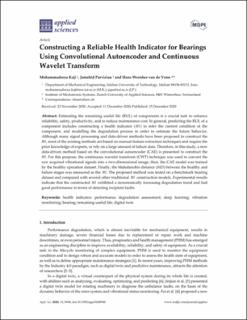Please use this identifier to cite or link to this item:
https://doi.org/10.21256/zhaw-21086| Publication type: | Article in scientific journal |
| Type of review: | Peer review (publication) |
| Title: | Constructing a reliable health indicator for bearings using convolutional autoencoder and continuous wavelet transform |
| Authors: | Kaji, Mohammadreza Parvizian, Jamshid van de Venn, Hans Wernher |
| et. al: | No |
| DOI: | 10.3390/app10248948 10.21256/zhaw-21086 |
| Published in: | Applied Sciences |
| Volume(Issue): | 10 |
| Issue: | 24 |
| Page(s): | 8948 |
| Issue Date: | 2020 |
| Publisher / Ed. Institution: | MDPI |
| ISSN: | 2076-3417 |
| Language: | English |
| Subjects: | Health indicator; Performance degradation assessment; Deep learning; Vibration monitoring; Bearing; Remaining useful life; Digital twin |
| Subject (DDC): | 621.8: Machine engineering |
| Abstract: | Estimating the remaining useful life (RUL) of components is a crucial task to enhance reliability, safety, productivity, and to reduce maintenance cost. In general, predicting the RUL of a component includes constructing a health indicator (𝐻𝐼 ) to infer the current condition of the component, and modelling the degradation process in order to estimate the future behavior. Although many signal processing and data‐driven methods have been proposed to construct the 𝐻𝐼, most of the existing methods are based on manual feature extraction techniques and require the prior knowledge of experts, or rely on a large amount of failure data. Therefore, in this study, a new data‐driven method based on the convolutional autoencoder (CAE) is presented to construct the 𝐻𝐼. For this purpose, the continuous wavelet transform (CWT) technique was used to convert the raw acquired vibrational signals into a two‐dimensional image; then, the CAE model was trained by the healthy operation dataset. Finally, the Mahalanobis distance (MD) between the healthy and failure stages was measured as the 𝐻𝐼. The proposed method was tested on a benchmark bearing dataset and compared with several other traditional 𝐻𝐼 construction models. Experimental results indicate that the constructed 𝐻𝐼 exhibited a monotonically increasing degradation trend and had good performance in terms of detecting incipient faults. |
| URI: | https://digitalcollection.zhaw.ch/handle/11475/21086 |
| Fulltext version: | Published version |
| License (according to publishing contract): | CC BY 4.0: Attribution 4.0 International |
| Departement: | School of Engineering |
| Organisational Unit: | Institute of Mechatronic Systems (IMS) |
| Appears in collections: | Publikationen School of Engineering |
Files in This Item:
| File | Description | Size | Format | |
|---|---|---|---|---|
| 2020_Kaji-etal_Reliable-health-indicator-for-bearings.pdf | 1.81 MB | Adobe PDF |  View/Open |
Show full item record
Kaji, M., Parvizian, J., & van de Venn, H. W. (2020). Constructing a reliable health indicator for bearings using convolutional autoencoder and continuous wavelet transform. Applied Sciences, 10(24), 8948. https://doi.org/10.3390/app10248948
Kaji, M., Parvizian, J. and van de Venn, H.W. (2020) ‘Constructing a reliable health indicator for bearings using convolutional autoencoder and continuous wavelet transform’, Applied Sciences, 10(24), p. 8948. Available at: https://doi.org/10.3390/app10248948.
M. Kaji, J. Parvizian, and H. W. van de Venn, “Constructing a reliable health indicator for bearings using convolutional autoencoder and continuous wavelet transform,” Applied Sciences, vol. 10, no. 24, p. 8948, 2020, doi: 10.3390/app10248948.
KAJI, Mohammadreza, Jamshid PARVIZIAN und Hans Wernher VAN DE VENN, 2020. Constructing a reliable health indicator for bearings using convolutional autoencoder and continuous wavelet transform. Applied Sciences. 2020. Bd. 10, Nr. 24, S. 8948. DOI 10.3390/app10248948
Kaji, Mohammadreza, Jamshid Parvizian, and Hans Wernher van de Venn. 2020. “Constructing a Reliable Health Indicator for Bearings Using Convolutional Autoencoder and Continuous Wavelet Transform.” Applied Sciences 10 (24): 8948. https://doi.org/10.3390/app10248948.
Kaji, Mohammadreza, et al. “Constructing a Reliable Health Indicator for Bearings Using Convolutional Autoencoder and Continuous Wavelet Transform.” Applied Sciences, vol. 10, no. 24, 2020, p. 8948, https://doi.org/10.3390/app10248948.
Items in DSpace are protected by copyright, with all rights reserved, unless otherwise indicated.